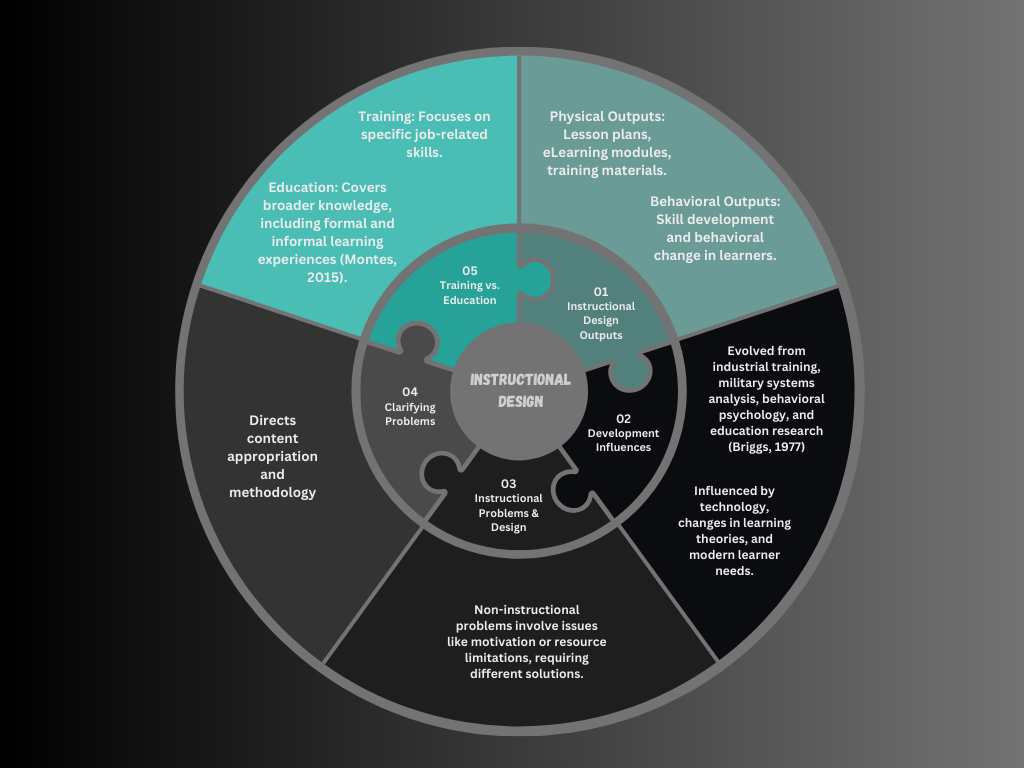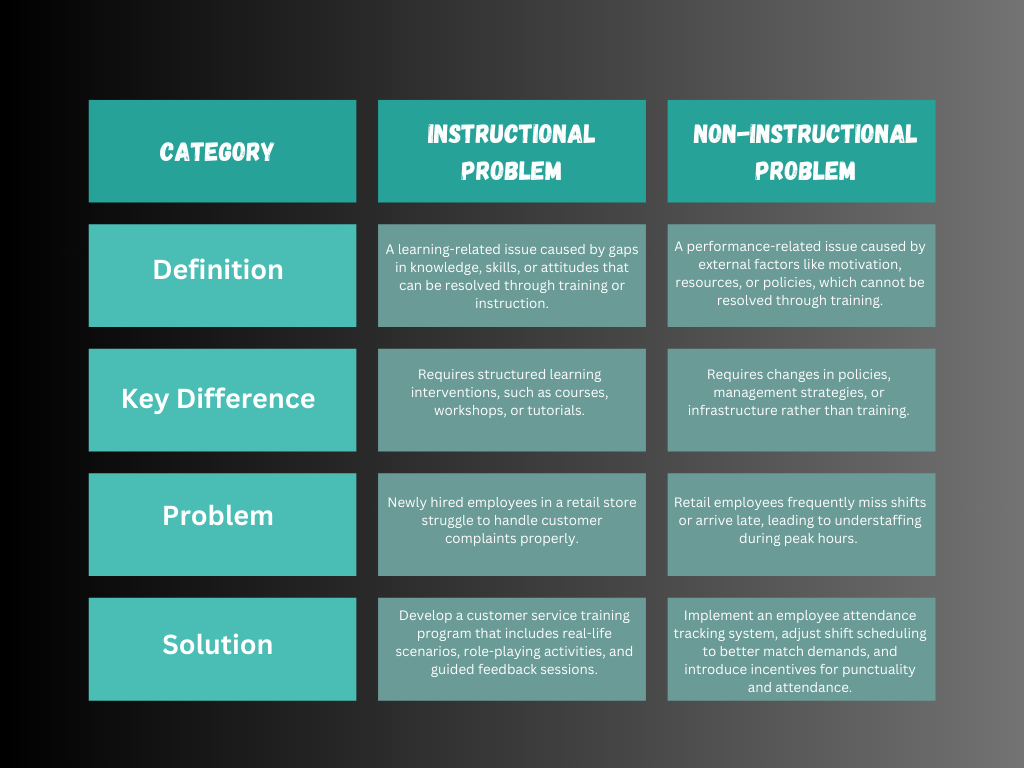LEARNING TASK
Let me say this upfront: learning happens anywhere. We know that. But structured, meaningful instruction? That requires planning—a specific kind of planning that doesn’t rely on guesswork or derivative strategies.
Instructional design tackles this. It works through what learners need, what slows them down, and how to support them in practical ways. Berger and Kaw (1996) called it one of the two core parts of instructional technology. Reiser (2001) explained that it responds to performance issues through planned instruction and non-instructional support when needed. Later, Reiser and Dempsey (2007) described it as a working system—pliable, reactive, and designed for consistency across different settings.
I summarized key elements based on course readings to better grasp how instructional design works. These include instructional outputs, what influences design development, identifying instructional problems, and the difference between training and education.

Figure 1: Concept Map for Overview of Instructional Design
Products or Outputs of Instructional Design
While instructional design’s tangible output includes but is not limited to lesson plans, eLearning modules, and training programs, well-designed instruction leads to behavioral changes that improve real-world performance (Reiser, 2001).
Consider Gemma, a newly hired sales associate in a department store who struggles with customer interactions and follows shoppers around, making them uncomfortable. A customer service training program introduces her to observational techniques, including recognizing nonverbal cues, such as tracking where a customer’s eyes focus. Through guided role-playing exercises and feedback, she learns to assess when a shopper genuinely needs assistance rather than approaching every customer the same way. This small behavioral adjustment enhances the shopping experience and demonstrates how instructional design leads to real-world improvements in performance.
Factors Affecting Its Development and Evolution
Instructional design evolved through insights from various fields, including industrial training, military systems analysis, behavioral psychology, and education research (Briggs, 1977). Each discipline contributed different strategies, but all emphasized the importance of structured learning. For instance, educational institutions frequently revise curricula or introduce new programs to meet industry demands and technological advancements. As learning theories evolve and technology advances, instructional design adapts to meet the changing needs of modern learners.
Instructional Problems vs. Non-Instructional Problems
Not every workplace challenge needs a training solution. Instructional design is meant to address gaps in knowledge, skills, or attitudes. When the root issue lies elsewhere, such as lack of tools or unclear policies—a different fix is needed.

Figure 2: Instructional and Non-instructional problem
Take customer service issues. If new hires struggle with handling complaints, a training program with real-life scenarios can build the skills they need. But if employees are constantly missing shifts, training won’t solve it. Maybe there’s a problem with scheduling or accountability. In that case, implementing an attendance tracking system would be more appropriate.
Recognizing the difference between instructional and non-instructional problems ensures that solutions directly address the root cause (Reiser, 2001).
Importance of Clarifying Instructional Problems
Jumping straight to training isn’t always the answer when performance issues arise. Sometimes, the real problem has nothing to do with knowledge or skills but rather with outdated processes, low motivation, or insufficient resources. Instructional design focuses on solving learning challenges, but not every issue can be fixed with training. McGriff (2019) pointed out that factors like unclear policies, poor working conditions, or lack of incentives can affect performance just as much as a knowledge gap. This is why identifying the root cause is essential—designing a solution without fully understanding the problem can lead to wasted time and effort.
Training vs. Education
Learning happens in different ways, depending on the goal. Training develops specific job-related skills, while education provides a broader foundation that extends beyond structured lessons (Montes, 2015). Formal education happens in classrooms, but learning also happens in everyday life. A graphic designer, for example, may earn a degree in design, gaining theoretical knowledge and artistic principles through formal education. However, if they are hired by a company that uses specialized design software, they may need additional training to master that specific tool. Instruction takes place in both structured and workplace settings, but education builds a wider knowledge base, while training focuses on immediate skill development.
Reflection
Before enrolling in the Associate Degree in Instructional Design and Technology, I thought instructional design was mainly about arranging lessons, creating activities, and assessments in a tidy format. I already took a foundational course, so I expected this would feel like a rerun—familiar, predictable. And to some extent, it was. But rereading the concepts didn’t feel repetitive. Sometimes, going through the same idea twice or more uncovers what you missed the first time.
After examining the readings on instructional outputs, development influences, and the distinction between training and education, I’m certain that a well-structured module doesn’t guarantee results if the tools, environment, or performance gaps remain unchecked. Some situations require education to build a foundation, while others call for targeted training to address immediate needs. This helped me focus less on delivering information and more on finding what blocks progress, then designing around that.
The readings also gave me a clearer grasp of instructional design. Reiser and Dempsey (2007) described it as reactive—responding to learning and performance challenges. That makes sense, but limiting it to reaction feels short-sighted. I believe it should do more than that. A reactive mindset can miss early signs of problems, and designers who wait to respond fall behind.
I remember a case study from one of the previous IDT courses—though the company’s name escapes me. Their team struggled to identify the root of a performance issue. Employees couldn’t pinpoint where things were going wrong. Leadership didn’t know where to begin. That uncertainty is common. Most people can’t diagnose the problem they’re in the middle of. Instructional designers don’t wait for issues to surface; asking better questions, collecting feedback, and making sense of overlooked patterns should be executed.
Instructional design thrives in feedback loops. That’s how it stays resurgent. That process gives it strength, but it also reveals its weakness. When teams treat instructional design as a tool for repair, they end up repeating the same mistakes. Why does that happen? Because they wait for failure before acting. They fix symptoms instead of tracing the root cause. This reactive mindset creates a cycle—designers patch issues temporarily. A proactive mindset looks ahead. It tracks trends, notices which modules learners skip, and flags when people hesitate to use a tool. Instead of waiting for problems to arise, proactive IDs build support early and involve stakeholders before decisions get locked in.
To me, being proactive in this field means working with foresight, and it involves two things: diagnosing the actual problem and prescribing the right fix. It doesn’t mean rushing into training. It means asking if training is even the right solution.
So, everything makes sense, especially the distinction between instructional and non-instructional problems. Training works when a skill or knowledge gap exists. Gemma’s case made that easy to see. She didn’t need another memo. She needed guided practice, relevant feedback, and tools that helped her shift how she interacted with customers. That kind of outcome only happens when instructional design gets to the root of the issue.
Instructional design comes from different fields—psychology, systems analysis, education, and workplace training. It doesn’t insist on one answer. Instead, it asks, “What’s the actual barrier here?” and moves from there. I’ve come to see instructional design’s work as part strategic and part adaptive. And honestly, it makes sense. People, tools, and systems aren’t static.
As a future instructional designer, I plan to pay close attention to the context behind each learning need. Instructional design designs paths to progress—paths shaped by context, culture, and access.
The landscape will keep shifting. So will learners. My job is to stay observant and create solutions that stay relevant and inclusive.
References
McGriff, S. (2019, October 17). Instructional problems presentation [Online video]. YouTube. https://www.youtube.com/watch?v=zNTN0yLeq1E
Molenda, M. H. (2022). History and development of instructional design and technology. In Handbook of open, distance and digital education. Springer. https://link.springer.com/content/pdf/10.1007/978-981-19-0351-9_4-1.pdf
Montes, B. (2015, December 1). An introduction to instructional design [Online video]. YouTube. https://youtu.be/4ayIoU0Bwxk
Peck, D. (2021, March 23). Which problems can instructional designers solve [Online video]. YouTube. https://www.youtube.com/watch?v=UXYUvdkyqq8
Raible, J. (2020). History of instructional design (Chap. 1). In Introduction to instructional design. Pressbooks. https://pressbooks.pub/itec51602/chapter/chapter-1/
Reiser, R. A. (2001). A history of instructional design and technology: Part II: A history of instructional design. Educational Technology Research and Development, 49(2), 57-67. https://docdrop.org/static/drop-pdf/A-history-of-instructional-design-and-technology-2-fV1ic.pdf
Wagner, E. (2018). What is this thing called instructional design?. In R. E. West (Ed.), Foundations of learning and instructional design technology. EdTech Books. https://edtechbooks.org/lidtfoundations/what_is_instructional_design




